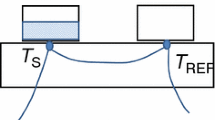Abstract
Two methods based on the release of inert radioactive gases were used to study processes taking place on heating of solids: the classical emanation method and the surface labelling method. The results obtained with the use of these methods are compared for the study of (a) substances which do not change chemically when being heated in the temperature range studied (e.g. α-Fe2O3), (b) substances in which dehydration and thermal decomposition takes place (e.g. Th(C2O4).6H2O).
For substances which exhibit chemical and structural changes when being heated, results of investigation by means of the two above mentioned radiochemical methods are compared with DTA and dilatometric data, obtained under identical experimental conditions. Apparatus permitting simultaneous measurement of the release of two radioactive gases, DTA and dilatometric measurement is described.
From the substances which do not change when being heated, values of the activation energy of diffusion of inert gases incorporated by different ways are discussed. The advantages of the emanation and surface labelling methods over other physico-chemical methods are given and the possibilities of their application for the study of processes taking place in solids on heating, are described.
Similar content being viewed by others
References
O. Hahn, “Applied Radiochemistry” (Cornell University Press, New York, 1936) P. 191.
K. E. Zimens, Z. physik. Chem. A191 (1942) 1; A191 (1942) 95; A192 (1943) 10.
I. E. Starik, “Osnovy radiokhimii” (Izd Akad Nauk, USSR, Moscow, 1960).
O. Hahn, J. Chem. Soc. S56 Suppl. 1949 259.
A. C. Wahl and N. A. Bonner, “Radioactivity Applied to Chemistry” (Wiley, New York, and Chapman & Hall, London, 1951).
G. M. Zhabrova and M. D. Shibanova, Uspekhi Khimiji 36 (1967) 1407.
V. Balek, Chem. Listy 58 (1964) 1261.
S. Yajima, S. Ichiba, Y. Kamemoto, and K. Shiba, Bull. Chem. Soc. Jap. 33 (1960) 426; 34 (1961) 133.
S. Kalbitzer, Z. Naturforsch. 17a (1962) 1071.
F. W. Felix and H. Seelig, Nukleonik 8 (1967) 389.
R. Kelly, Can. J. Chem. 39 (1961) 2411.
R. Lindner and Hj. Matzke, Z. Naturforsch. 15a (1960) 1082.
D. Chleck, R. Maehl, O. Cucchiara, and E. Carnevale, Int. J. Appl. Rad. and Isotopes 14 (1963) 581.
G. Carter, Vacuum 9 (1959) 190.
R. Kelly and F. Brown, Acta Met. 13 (1965) 169.
Č. Jech, Int. J. Appl. Rad. and Isotopes 8 (1960) 179.
M. D. Freshley, F. E. Panisko, and R. E. Skavdahl, Trans. Am. Nucl. Soc. 9 (1966) 397.
M. E. Levina, B. S. Shershev, and K. B. Zaborenko, Radiokhimija 4 (1963) 480.
A. I. Czekhovskhikh, D. Nitzold, K. B. Zaborenko, and S. I. Volfkovich, Zh. neorg. Khim. 11 (1966) 1948.
K. B. Zaborenko, D. Nitzold, and V. I. Korobkov, Radiokhimija 5 (1963) 642.
K. B. Zaborenko and I. N. Bekman, ibid 10 (1968) 268.
K. B. Zaborenko, L. L. Melichov, and V. A. Portyanoj, ibid 7 (1965) 319.
K. E. Zimens, Z. physik. Chem. A186 (1940) 94.
S. Flügge and K. E. Zimens, ibid B42 (1939) 179.
G. Tammann and A. Sworykin, Z. anorg. allgem. Chem. 176 (1928) 46.
L. G. Cook, Z. physik. Chem. B42 (1939) 221.
V. Balek, J. Materials Sci, submitted for publication.
P. A. Redhead, Vacuum 12 (1962) 203.
R. Kelly and H. J. Matzke, J. Nucl. Matls. 20 (1966) 171.
G. Carter, Vacuum 12 (1962) 245.
Č. Jech and R. Kelly, J. Phys. and Chem. Sol. in press.
Idem,, Proc. Brit. Ceram. Soc. 9 (1967) 259.
Hj. Matzke, Can. J. Phys. 46 (1968) 621.
R. Lindner, Arkiv. Kemi 4 (1952) 381.
W. G. Hagel, Trans. Met. Soc. AIME 236 (1966) 179.
Hj. Matzke, J. Materials Sci. 2 (1967) 444.
S. Ichiba, J. Jap. Soc. Powder Metall. 9 (1962) 169.
P. Bussiére, B. Claudel, J. P. Renouf, Y. Trambouze, and M. Prettre, J. Chim. Phys. 58 (1961) 668.
D. K. Srivastava and A. P. Vasudeva Murphy, J. Sci. and Ind. Res. 21B (1962) 525.
Č. Jech, G. M. Zhabrova, S. Z. Roginksij, and M. D. Shibanova, Dokl. Akad. Nauk USSR 164 (1965) 1343.
A. V. Skharin, G. M. Zhabrova, N. P. Topor, and M. Ya. Kushnarev, Izv. Toms. Politech. Instituta, in press.
R. Beckett and M. E. Winifield, Austral. J. Sci. Res. A4 (1951) 664.
R. W. M. Déye and P. G. Seelmann, J. Inorg. and Nucl. Chem. 1 (1955) 143.
K. B. Zaborenko and R. Thätner, Zhur. neorg. Khim. 11 (1966) 2198.
V. Balek, J. Radioanal. Chem. 2 (1969) 315.
K. B. Zaborenko and V. Balek, Zhur. neorg. Khim. 14 (1969) 1469.
Author information
Authors and Affiliations
Additional information
The experimental part of this study was carried out during the author's stay at the Radiochemistry Dept, Moscow State University.
Rights and permissions
About this article
Cite this article
Balek, V. Application of inert radioactive gases in the study of solids. J Mater Sci 4, 919–927 (1969). https://doi.org/10.1007/BF00549784
Received:
Issue Date:
DOI: https://doi.org/10.1007/BF00549784




